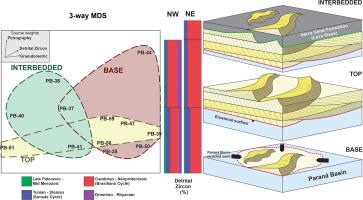Sedimentary Geology ( IF 2.7 ) Pub Date : 2021-03-06 , DOI: 10.1016/j.sedgeo.2021.105883 G. Bertolini , J.C. Marques , A.J. Hartley , M.A.S. Basei , J.C. Frantz , P.R. Santos

|
The Lower Cretaceous Botucatu Formation comprises a dry-aeolian system developed in western Gondwana and preserved within the Paraná Basin of central South America. Multiproxy provenance analysis (detrital zircon U Pb dating, heavy mineral, petrographic and granulometric analysis) was undertaken along two 500 km transects of the northern Paraná Basin (NW and NE transects). To assess the provenance variation within the aeolian stratigraphy, samples were taken from the base and top of the Botucatu Formation and from sandstones interbedded with volcanics in the overlying Serra Geral Formation. Granulometric analysis shows a mean fine- to very fine-grained sand. The bulk petrography yields an average composition of Q91F6L2, and heavy mineral analysis gives a mean of 86% of zircon-tourmaline-rutile, demonstrating the overall polycyclic nature of the sediment. The discrete occurrence of garnet, apatite and epidote indicates local sediment input points, providing indirect evidence for point-sourced fluvial input into an overall dry aeolian system. Detrital zircon U
Pb dating, heavy mineral, petrographic and granulometric analysis) was undertaken along two 500 km transects of the northern Paraná Basin (NW and NE transects). To assess the provenance variation within the aeolian stratigraphy, samples were taken from the base and top of the Botucatu Formation and from sandstones interbedded with volcanics in the overlying Serra Geral Formation. Granulometric analysis shows a mean fine- to very fine-grained sand. The bulk petrography yields an average composition of Q91F6L2, and heavy mineral analysis gives a mean of 86% of zircon-tourmaline-rutile, demonstrating the overall polycyclic nature of the sediment. The discrete occurrence of garnet, apatite and epidote indicates local sediment input points, providing indirect evidence for point-sourced fluvial input into an overall dry aeolian system. Detrital zircon U Pb LA-ICP-MS dating demonstrates a dominant Cambrian to Late Neoproterozoic (520–750 Ma) population with subsidiary Tonian-Stenian (0.9–1.2 Ga) and Orosirian-Rhyacian (1.9–2.3 Ga) contributions. The Botucatu Formation along the northern basin margin displays similar provenance to the southern part of the basin, pointing to a predominance of recycling processes within the basin. Statistical plots illustrate the detrital zircon age variability - recording an upward decrease in the age proportion of Permian and Tonian-Stenian populations and an increase in Cambrian-Late Neoproterozoic dates towards the top. Such variability can be related to the recycling of distinct Paraná Basin strata. The proportion of Cambrian-Late Neoproterozoic dates increases in the NE, indicating a possible input from the Ribeira Belt granitoids. Similar to major-scale dune-fields, Botucatu erg register variable sand sources there are possibly linked with coexisting depositional systems. In summary, the northern Botucatu erg is mostly fed by local sources reworked from underlying Paraná Basin units, with little direct input from basement sources and limited impact of regional wind-pattern variability.
Pb LA-ICP-MS dating demonstrates a dominant Cambrian to Late Neoproterozoic (520–750 Ma) population with subsidiary Tonian-Stenian (0.9–1.2 Ga) and Orosirian-Rhyacian (1.9–2.3 Ga) contributions. The Botucatu Formation along the northern basin margin displays similar provenance to the southern part of the basin, pointing to a predominance of recycling processes within the basin. Statistical plots illustrate the detrital zircon age variability - recording an upward decrease in the age proportion of Permian and Tonian-Stenian populations and an increase in Cambrian-Late Neoproterozoic dates towards the top. Such variability can be related to the recycling of distinct Paraná Basin strata. The proportion of Cambrian-Late Neoproterozoic dates increases in the NE, indicating a possible input from the Ribeira Belt granitoids. Similar to major-scale dune-fields, Botucatu erg register variable sand sources there are possibly linked with coexisting depositional systems. In summary, the northern Botucatu erg is mostly fed by local sources reworked from underlying Paraná Basin units, with little direct input from basement sources and limited impact of regional wind-pattern variability.
中文翻译:

确定冈瓦纳虫族的沉积物起源历史:巴西北巴拉那盆地的Botucatu组
下白垩纪Botucatu组包括在冈瓦纳西部发育的风成风系统,并保留在南美洲中部的Paraná盆地内。 沿着巴拉那盆地北部的两个500 km断面(西北和东北断面)进行了多代理物源分析(碎屑锆石U Pb测年,重矿物,岩石学和粒度分析)。为了评估风成地层内的物源变化,从Botucatu组的底部和顶部以及上覆的Serra Geral组中与火山岩夹层的砂岩中取样。粒度分析显示出平均细至极细砂。整体岩相学的平均组成为Q 91 F 6 L 2,重矿物分析表明,锆石-电气石-金红石的平均含量为86%,这说明了沉积物的整体多环性质。石榴石,磷灰石和附子的离散出现指示了局部沉积物输入点,从而为以点源为基础的河流输入到整个干燥的风成系统提供了间接证据。碎屑锆石U
沿着巴拉那盆地北部的两个500 km断面(西北和东北断面)进行了多代理物源分析(碎屑锆石U Pb测年,重矿物,岩石学和粒度分析)。为了评估风成地层内的物源变化,从Botucatu组的底部和顶部以及上覆的Serra Geral组中与火山岩夹层的砂岩中取样。粒度分析显示出平均细至极细砂。整体岩相学的平均组成为Q 91 F 6 L 2,重矿物分析表明,锆石-电气石-金红石的平均含量为86%,这说明了沉积物的整体多环性质。石榴石,磷灰石和附子的离散出现指示了局部沉积物输入点,从而为以点源为基础的河流输入到整个干燥的风成系统提供了间接证据。碎屑锆石U 铅LA-ICP-MS测年表明,寒武纪至新元古代晚期(520-750 Ma)占优势,伴有Tonian-Stenian(0.9-1.2 Ga)和Orosirian-Rhyacian(1.9-2.3 Ga)。盆地北部边缘的Botucatu组与盆地南部的物源相似,表明该盆地内的回收过程占主导地位。统计图说明了碎屑锆石的年龄变异性-记录了二叠纪和Tonian-Stenian人口年龄比例的上升趋势,以及寒武纪晚期新元古代的上升趋势。这种可变性可能与巴拉那盆地(ParanáBasin)独特地层的循环利用有关。东北地区寒武纪晚期新元古代日期的比例增加,表明可能是里贝拉带花岗岩的输入。与大型沙丘场相似,Botucatu erg记录着可变的砂源,可能与共存的沉积系统有关。总之,北部的Botucatu erg大部分是由基础巴拉那盆地单元返工的本地资源提供的,而来自地下资源的直接投入很少,并且区域风型变化的影响有限。
铅LA-ICP-MS测年表明,寒武纪至新元古代晚期(520-750 Ma)占优势,伴有Tonian-Stenian(0.9-1.2 Ga)和Orosirian-Rhyacian(1.9-2.3 Ga)。盆地北部边缘的Botucatu组与盆地南部的物源相似,表明该盆地内的回收过程占主导地位。统计图说明了碎屑锆石的年龄变异性-记录了二叠纪和Tonian-Stenian人口年龄比例的上升趋势,以及寒武纪晚期新元古代的上升趋势。这种可变性可能与巴拉那盆地(ParanáBasin)独特地层的循环利用有关。东北地区寒武纪晚期新元古代日期的比例增加,表明可能是里贝拉带花岗岩的输入。与大型沙丘场相似,Botucatu erg记录着可变的砂源,可能与共存的沉积系统有关。总之,北部的Botucatu erg大部分是由基础巴拉那盆地单元返工的本地资源提供的,而来自地下资源的直接投入很少,并且区域风型变化的影响有限。











































 京公网安备 11010802027423号
京公网安备 11010802027423号